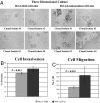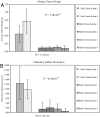Bromodomain 4 activation predicts breast cancer survival
- PMID: 18427120
- PMCID: PMC2359777
- DOI: 10.1073/pnas.0710331105
Bromodomain 4 activation predicts breast cancer survival
Abstract
Previous work identified the Rap1 GTPase-activating protein Sipa1 as a germ-line-encoded metastasis modifier. The bromodomain protein Brd4 physically interacts with and modulates the enzymatic activity of Sipa1. In vitro analysis of a highly metastatic mouse mammary tumor cell line ectopically expressing Brd4 demonstrates significant reduction of invasiveness without altering intrinsic growth rate. However, a dramatic reduction of tumor growth and pulmonary metastasis was observed after s.c. implantation into mice, implying that activation of Brd4 may somehow be manipulating response to tumor microenvironment in the in vivo setting. Further in vitro analysis shows that Brd4 modulates extracellular matrix gene expression, a class of genes frequently present in metastasis-predictive gene signatures. Microarray analysis of the mammary tumor cell lines identified a Brd4 activation signature that robustly predicted progression and/or survival in multiple human breast cancer datasets analyzed on different microarray platforms. Intriguingly, the Brd4 signature also almost perfectly matches a molecular classifier of low-grade tumors. Taken together, these data suggest that dysregulation of Brd4-associated pathways may play an important role in breast cancer progression and underlies multiple common prognostic signatures.
Conflict of interest statement
The authors declare no conflict of interest.
Figures



References
-
- Chung CT, Carlson RW. Goals and objectives in the management of metastatic breast cancer. Oncologist. 2003;8:514–520. - PubMed
-
- Guarneri V, Conte PF. The curability of breast cancer and the treatment of advanced disease. Eur J Nucl Med Mol Imaging. 2004;31(Suppl 1):149–161. - PubMed
-
- Lifsted T, et al. Identification of inbred mouse strains harboring genetic modifiers of mammary tumor age of onset and metastatic progression. Int J Cancer. 1998;77:640–644. - PubMed
-
- Hunter KW, et al. Predisposition to efficient mammary tumor metastatic progression is linked to the breast cancer metastasis suppressor gene Brms1. Cancer Res. 2001;61:8866–8872. - PubMed
-
- Lancaster M, Rouse J, Hunter KW. Modifiers of mammary tumor progression and metastasis on mouse chromosomes 7, 9, and 17. Mamm Genome. 2005;16:120–126. - PubMed
Publication types
MeSH terms
Substances
Grants and funding
LinkOut - more resources
Full Text Sources
Other Literature Sources
Medical

